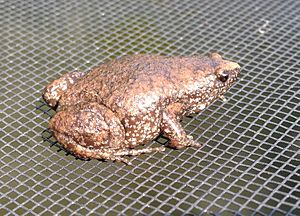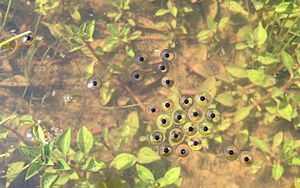Eastern narrow-mouthed toad facts for kids
Quick facts for kids Eastern narrow-mouthed toad |
|
|---|---|
 |
|
| Eastern narrow-mouthed toad | |
| Conservation status | |
| Scientific classification | |
| Synonyms | |
|
Engystoma carolinense Holbrook, 1835 |
The Gastrophryne carolinensis, also known as the eastern narrow-mouthed toad, is a small, toad-like frog. It belongs to a family of frogs called microhylids. Even though it's called a "toad," it's not a true toad. It gets its name because it lives on land.
These amphibians are often found in wet, shady places. They spend a lot of time underground and mostly eat ants. You can tell them apart from other frogs because they have smooth, moist skin. They also don't have visible eardrums and have a unique fold of skin above their eyes. You can find them in the United States, from Maryland down to the Florida Keys, and west to Missouri and Texas.
Contents
What Does the Eastern Narrow-Mouthed Toad Look Like?
The eastern narrow-mouthed toad is quite small. It usually grows to about 2.1 inches (5.3 cm) long. It has an oval-shaped body and a narrow head with a pointy snout. Their colors can vary from brown and gray to green. They often have black and white spots.
Their skin is smooth and doesn't have bumps or warts. This tough skin helps protect them from the ants they eat. The toad's color can change depending on what it's doing or where it is. Its back is usually dark with lighter spots or patches. Its belly is often mottled, but some toads in the Great Plains have plain bellies.
Their legs are short and strong. Their toes are round and don't have webbing or pads. They have a special "spade" or bump on their back feet. This helps them dig into the ground.
You can easily tell male and female toads apart. Males have a dark throat area, especially during breeding season. Females do not have this dark coloring.
Where Do These Toads Live?
The eastern narrow-mouthed toad can live at heights up to 1,800 feet (550 meters). They are usually not found in most of the Blue Ridge Mountains or the Appalachian Mountains.
This toad is one of only three species from its frog family that live in the United States. They live in the southeastern part of the US. This area stretches from Missouri and eastern Texas to southern Maryland and the Florida Keys. There's also a small group in Iowa. They have also been brought to the Bahamas and the Cayman Islands.
These toads live in many different places. But they always need moisture and shelter. They can live near fresh water or on land. They use both temporary and permanent water sources. They can even live in places changed by humans. They tend to avoid very dry areas and mountains.
Some common places where they live include:
- Edges of swamps
- Cypress-gum swamps
- Forests near rivers
- Pine and oak woodlands
- Sandy areas and hillsides
- Open woods and pine forests
- Small streams
- Under logs or near ponds with fallen leaves
- City areas like wooded lots
- Suburban areas with sandy soil
How Many Toads Are There?
There are many eastern narrow-mouthed toads across most of their living areas. This includes many suburban places. The toads brought to Grand Cayman are also very common. Even though this toad species faced a big drop in numbers in the past, their population has grown back. It is now stable.
Adult toads are about 0.9 to 1.4 inches (22 to 35 mm) long. Females are usually bigger than males. Males are typically an inch (25 mm) or less. During breeding season, males have a dark vocal sac on their throat. They also have bigger bumps on their chin.
How Do They Breed?
Eastern narrow-mouthed toads breed in water. They can use temporary ponds or permanent water bodies. They will only breed in deep water if it's covered with lots of plants or debris. They also use temporary spots like roadside ditches or puddles in roads.
Male toads call to attract females when they are ready to breed. They usually call from the edge of the water, hidden by plants. Sometimes, they float in the water while calling. They can also call from a bank or from damp sand on rainy nights, with only their head showing.
Their mating call sounds like a high-pitched, buzzing bleat, like a sheep. It lasts about 1 to 1.5 seconds. Unlike many other frogs, their call doesn't have a typical trill sound.
In the southern areas, heavy rains from April to October start their breeding season. In northern areas, it's midsummer. They gather at breeding ponds after spring and early summer rains. This species is very good at breeding in temporary water bodies. When a male grabs a female for mating, he releases a sticky substance. This helps him hold onto the female and stop other males from pushing him off.
The female lays clear, marble-like eggs on the water's surface. They are laid in round or square clusters of 10 to 150 eggs. A female can lay over 800 tiny eggs. These eggs hatch in about 1.5 to 3 days.
How Do Tadpoles Grow?
Tadpoles change into toads in about 23 to 67 days. Unlike other tadpoles, they filter tiny bits of food, like plankton, from the water.
The tadpoles have pointy heads with eyes on the sides. Their bodies are very dark, almost black, with blue flecks. Their bellies have whitish spots. A white stripe runs from their body to their tail. They don't have the beak-like mouths that most tadpoles have.
Newly changed toads are small, about 0.3 to 0.5 inches (7 to 12 mm) long. They live in the same places as adult toads. Older tadpoles are toxic, which means they can harm predators. Males become ready to breed in one year. Females are ready in one to two years.
What Do They Eat?
These toads mainly eat ants, termites, and small beetles. They have been seen eating right at the entrance of ant hills. These insects make up about 75% of their diet. They also eat small snails, spiders, mites, and other tiny creatures.
Life and Behavior of the Toad
Eastern narrow-mouthed toads are not good jumpers. They either run or move with short, quick hops. Males usually move around more than females. These toads are mostly active at night. During the day, they stay underground or hidden in debris.
Some animals that eat these toads include copperhead snakes and common garter snakes. Other predators are glossy watersnakes, eastern cottonmouth snakes, and cattle egrets (a type of bird).
This toad avoids predators by digging underground or hiding. Being active at night also helps. They can also produce a sticky mucus that causes a burning feeling and irritates membranes. The toxins from their skin scare off predators. These toxins also help protect them from ant attacks when they hunt near ant mounds.
These toads are excellent at burrowing. Because of this, they are rarely seen above ground. Even if there are many of them, you might not know they are there. They don't seem to have territories. But male toads calling for mates can be very close to each other, sometimes just 2 cm apart.
Conservation Status
The eastern narrow-mouthed toad is listed as a species of "least concern" by the IUCN Red List. This means they are not currently at risk. This is because they have a large population, live in many different places, and can adapt to various habitats. So, no special actions are needed to protect them right now. However, the population in northern Maryland is protected as an endangered species.
See also
 In Spanish: Gastrophryne carolinensis para niños
In Spanish: Gastrophryne carolinensis para niños





